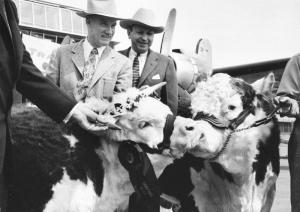Fleming bringing Polled Herefords back to Lewes
In the late 1700s, herdsmen in the Herefordshire region of England began perfecting a strain of weather-hardy beef cattle. Two hundred years later in Lewes, menhaden magnate Otis Smith saw promise in a hornless variety of those white-faced English Herefords.
Never a man to go after a project in a small way, Smith bought the national champion Polled Hereford bull - Battlemixer - from a ranch in Oklahoma. Then he bought Lady Larry from an upper Midwest ranch; she also was from a strain of national champion Herefords.
Polled means hornless, but it doesn’t mean hornyless. The two started an internationally acclaimed herd that in a decade numbered in the hundreds.
The grazing cattle brought life to the pastures of Smith’s Bay Manor Farm, surrounding his Gills Neck Road menhaden mansion. Herefords by that time had become the world’s dominant strain of beef cattle. Polled Herefords were especially prized because of the quality of their beef, and hides unmarred in transport by horn-inflicted wounds.
The Smiths’ fields grew lush with the feed they grew for their cattle and for the harness horses that Otis’ wife Hazell began breeding, training and showing on the farm. Just as Smith’s menhaden industry with its fishing vessels and specialized docks and buildings enhanced the distinctively maritime air of Lewes, the Smiths’ cattle and horse operations accentuated the agricultural heritage of the town’s surrounding area.
Their custom-built barns, carefully tended grain fields, pastures and show fields drew royalty from island nations around the world and agricultural representatives from many nations interested in adopting the Smiths’ successful practices for their own people.
In the early 1970s, depleted fishing stocks in the mid-Atlantic forced Smith to move himself and his menhaden operations to Louisiana. That move also spelled the eventual end of his Polled Hereford enterprises. The fields reverted to small-grain production; the barns grew increasingly quiet, and the varied agricultural scene began to fade.
Herefords have returned
Sixty years later, however, around Memorial Day in 2016, Ed Fleming acted on his desire to bring back pieces of that previous agricultural glory.
A neighbor down Gills Neck Road from the Smith mansion, Fleming and his Lawns Unlimited enterprise had been taking care of the Smith grounds for years. When Karen Parker took over ownership of the mansion and grounds following the death of her Aunt Hazell, she wondered out loud to Fleming what she would do with the pastures.
“I suggested that we put some Polled Herefords there,” said Fleming. “Karen was thrilled with the idea, remembering that her Uncle Otis had once raised cattle in those pastures decades before.”
An agronomist by training, Fleming knew how to rejuvenate the pastures to produce high-nutrient grasses for their feed. He purchased a registered Polled Hereford bull and eight Hereford heifers. Heifers are young female cattle not previously bred.
Within the first year, seven of the eight became pregnant. This spring, the tall grasses of the Gills Neck pasture came alive with the bleating of Hereford calves, and the herd nearly doubled. Fleming’s goal is to eventually have the herd supply hormone-free, natural, grass-fed beef for the regional market.
He has also leased land from another Gills Neck Road neighbor, Ron Smith, to grow a crop of triticale for winter feed. A wheat and rye hybrid, triticale is harvested green when its moisture content is high. “Then it’s wrapped in tight plastic tubes where, with little oxygen, bacteria convert the juices into high-quality protein,” said Fleming. “That anaerobic process makes the converted feed sweeter than sweet. You should smell it when we open the plastic. And of course the cows love it.”
Fleming said he doesn’t expect the herd to grow much larger than 25 to 30 head. “It’s based on pasture acreage. You usually figure about one cow per acre.”
The idea of producing all-natural beef and caring for the herd with his son Toby appeals to Fleming. He likes the fact that people stop along the road to look at the cattle, watching calves being born, seeing barns starting to be reused for the original intent, getting a taste of what this part of Lewes used to look like.
“I want to put more farming back into the city of Lewes,” said Fleming. “There’s some farming, but it’s mostly going to houses. I’m glad to be putting animals back into the country.”
























































